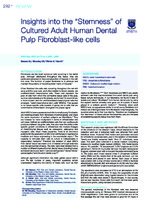| dc.contributor.author | Basson, N.J. | |
| dc.contributor.author | Moodley, D.S. | |
| dc.contributor.author | Olivier, A. | |
| dc.contributor.author | Hiss, D. | |
| dc.date.accessioned | 2019-10-18T10:18:59Z | |
| dc.date.available | 2019-10-18T10:18:59Z | |
| dc.date.issued | 2018 | |
| dc.identifier.citation | Basson, NJ, Moodley, DS, Olivier, A, & Hiss, D. (2018). Insights into the "Stemness" of Cultured Adult Human Dental Pulp Fibroblast-like cells. South African Dental Journal , 73(4), 292-296. | en_US |
| dc.identifier.issn | 0375-1562 | |
| dc.identifier.uri | http://ref.scielo.org/89wyz4 | |
| dc.identifier.uri | http://hdl.handle.net/10566/5045 | |
| dc.description.abstract | Fibroblasts are the most numerous cells occurring in the dental pulp. Although distributed throughout the tissue, they are particularly abundant in the coronal portion of the pulp in the cell-rich zone. The function of pulpal fibroblasts is to produce and maintain the proteins of the extracellular matrix of the pulp.
Other fibroblast-like cells also occurring throughout the cell-rich zone and the pulp core, and often related to blood vessels, are undifferentiated mesenchymal cells. These cells represent the pool of cells from which the connective tissue cells of the pulp, such as odontoblasts and fibroblasts, are formed. In recent times, a more modern term for undifferentiated mesenchymal cells has emerged: "adult mesenchymal stem cells" (MSC's). They appear to be tissue-specific cells capable of giving rise to cells that are committed to differentiation once given the proper signal.
Adult MSC's have a appearance similar to small young fibroblasts, are indistinguishable from fibroblasts morphologically and share the same expression of surface antigens as fribroblasts. They are however far more multipotent in terms of differentiation into cell types. Defined as undifferentiated cells that can continuously produce unaltered daughter cells, they also have the ability under specific growth conditions to differentiate into multiple lineages of mesenchymal tissues such as osteogenic, adipogenic and myogenic cells. Given these properties, there is an enormous potential for the application of MSC's for cell therapy in regenerative medicine and tissue engineering in the craniofacial region. The capacity to stimulate stem cells in culture is indispensable in regenerative medicine. Therefore the isolation of adult MSC's from dental tissue has drawn a lot of interest amongst scientists over the last number of years, The cells have been isolated from a number of different types of human dental tissue, including human exfoliated deciduous teeth, periodontal ligament, dental follicle, apical papilla, and the adult dental pulp.
Although significant information has been gained about MSC's over the last number of years, important questions remain unanswered regarding the identity of these cells, such as their relation to fibroblasts. Both fibroblasts and MSC's are plastic adherent cells that may be isolated from adult dental pulp using tissue culture techniques. In our laboratory we found it easy to isolate and culture "fibroblasts" from human dental pulp by using the explant method whereby cells grow out of a piece of tissue placed in a suitable growth medium. However, since adult MSC's have an appearance similar to small young fibroblasts and indeed are indistinguishable from fibroblasts morphologically, the question arose as to their true identity. Therefore we investigated the "sternness" of these cultured fibroblast-like cells and the ease of establishing specific tissue lines from them. | en_US |
| dc.language.iso | en | en_US |
| dc.publisher | The South African Dental Association (SADA) | en_US |
| dc.subject | Fibroblasts | en_US |
| dc.subject | Dental pulp | en_US |
| dc.subject | Pulp core | en_US |
| dc.subject | Adult mesenchymal stem cells (MSC's) | en_US |
| dc.subject | Cell therapy | en_US |
| dc.title | Insights into the "stemness" of cultured adult human dental pulp fibroblast-like cells | en_US |
| dc.type | Article | en_US |

